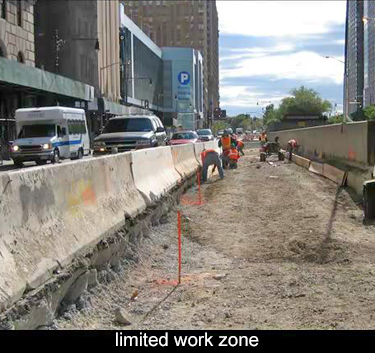Here is a view of the south end of the project. The configuration and the approach here is a little different. We're going to go through some of these steps. This is a very densely traveled way. This occurs right at the discharge end of the Brooklyn Battery Tunnel. There is a constant flow of traffic exiting the tunnel. The traffic was all squeezed to the right and that left one very narrow strip, which could be reconstructed.
 Here's a good view of that strip. It is barely 12 feet wide. In fact, a special form work had to be constructed here, because the metal forms could not be used. They were slightly too wide. You can see all the traffic is over on the left side, three lanes of it. The work is progressing in this very narrow slot. It's really impossible to get equipment back and forth. To provide access for the contractor, it was agreed that during off-peak hours, during the day, one lane adjoining this construction could be taken out of service and two lanes of traffic would be maintained.
Here's a good view of that strip. It is barely 12 feet wide. In fact, a special form work had to be constructed here, because the metal forms could not be used. They were slightly too wide. You can see all the traffic is over on the left side, three lanes of it. The work is progressing in this very narrow slot. It's really impossible to get equipment back and forth. To provide access for the contractor, it was agreed that during off-peak hours, during the day, one lane adjoining this construction could be taken out of service and two lanes of traffic would be maintained.
That finally allowed construction equipment to park alongside of the construction area and service the area. That was the only way the work could proceed. A similar Arrangement could be obtained at night, where one lane could be devoted to the contractor and two travel Lanes would be provided for the public. That was absolutely needed to get through this really confined space.
In this view, you can see that the new lane has been constructed. It's just barely 12 feet wide. and it completely fills the space that was available. There is another interesting feature here. You can see the three lanes of traffic. That's the normal configuration. Three lanes are always maintained, except as I say, during off-peak hours, one lane could be taken out of service to provide the space for contractor’s equipment - in which case, two lanes would be maintained.
You can see that the existing roadway in this area is actually four lanes wide. All of that space could have been used to facilitate the new construction, but as things always happen, there is a conflict with some adjoining construction. There is a building renovation taking place here on the left of the photo and one lane has been devoted to accommodating that construction activity.
One lane has been permanently closed in this area, providing only three available Lanes. It's an unfortunate coincidence that both of these projects are taking place at the same time and competing for this very limited available space.
This lane has now been completed and placed in service and that allows construction to take place on the next lane, again in an extremely narrow workspace. Here you can clearly see how only two lanes can pass, because the third lane is occupied by a sidewalk bridge providing protection for the adjacent building renovation.
This configuration is called a chute. The traffic occupies this very narrow space, with absolutely no room to pass a disabled vehicle. If there is a breakdown in this lane, everything just comes to a standstill and traffic gets backed up. On many projects, you actually park a tow truck in a convenient place, so that it can be immediately backed into the chute and the disabled vehicle can be pulled out of the way.
A chute is a very undesirable configuration. You really try to avoid it where you can, but, occasionally, there simply is no option. The chute and that supporting tow truck is the only remedy that you have.
During the off-peak hours, this roadway can be closed. It's been closed here by some barrels. And these are contractors' vehicles used to support the construction. What you're looking at here are insulated blankets. This is the winter and you want to preserve the subgrade and prevent any frost in the subgrade. You then wait for a promising day of weather and, during that day, you can place the concrete cover the concrete with insulated blankets. That's how you can keep the work moving during the winter months.